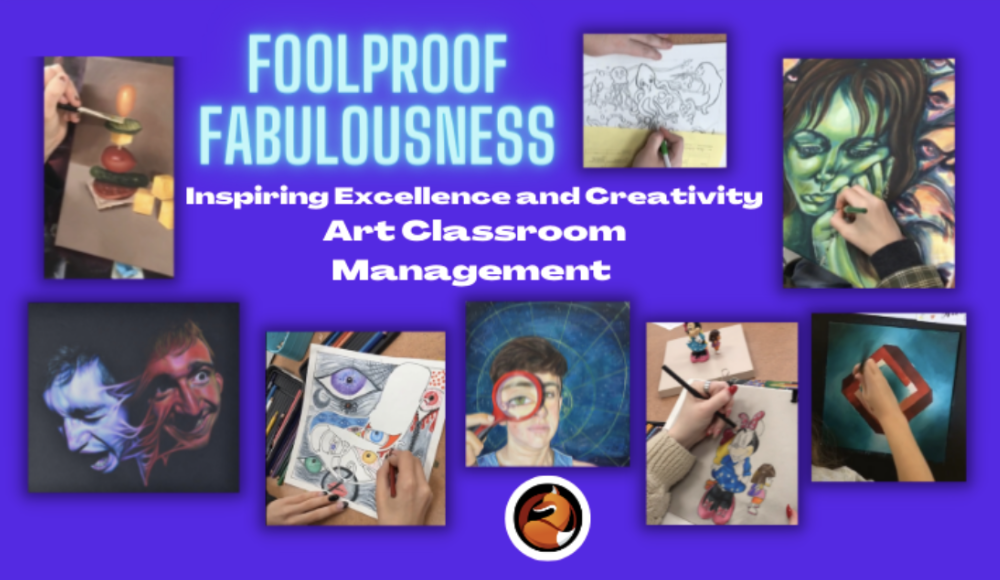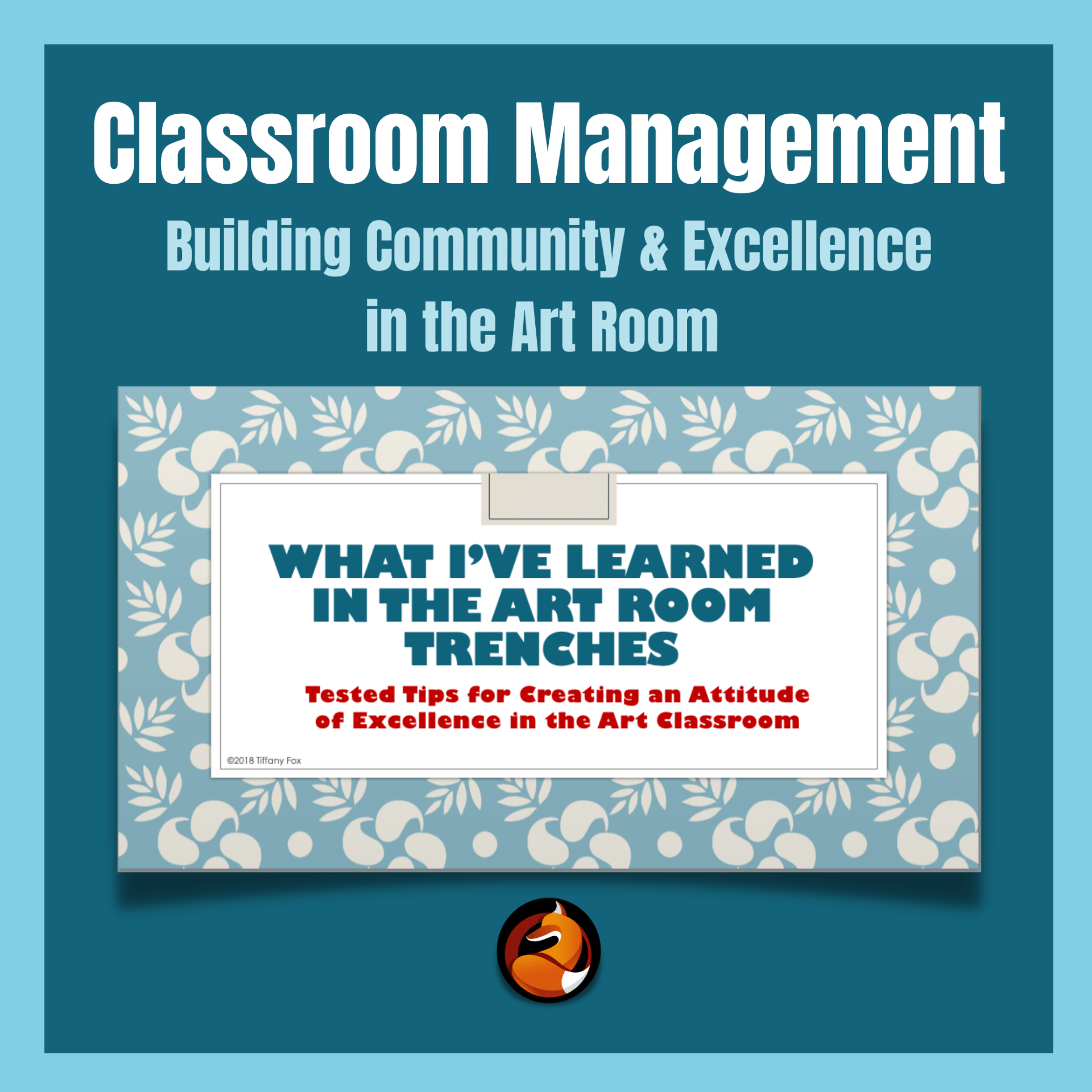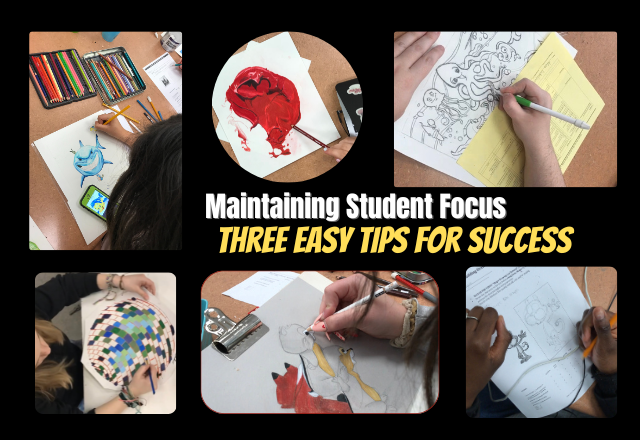Three Free and Easy Strategies for keeping your art students on track
It can be really intimidating learning how to keep your art students focused on success day in and day out. There are so many things fighting for their attention, and as art educators in these high-tech post pandemic times, we are required to fight for this attention that much harder. Well, we’re creative people, right? Who’s more resourceful than us? Nobody. But that doesn’t mean it’s not terrifying at times.
If you’ve been to my rodeo before, you know I’m about to tell a story. Stick with me, it’s relevant.
I promise.
The Recurring Art Teacher Nightmare
Last night it happened.
The Epic Educator Night Terror
Episode #243
You know the teacher nightmare…you walk into class and see 100 plus kids and you have no roster.
Objects are being catapulted across the room and the noise is deafening.
You try to talk and no words come out.
You look up and the room is empty.
Everyone is gone but one kid who’s in the middle of the room eating a piece of pound cake.
What???
You run desperately up and down the halls trying to find the kids.
You panic.
You turn the corner and suddenly you’re on the top floor of the Charlotte-Douglas International Airport parking garage.
East deck.
You see 100 kids milling about.
You try to rally the kids but no one is listening.
You panic…
I know exactly what you’re thinking. That favorite – or worse, recurring – night terror is replaying in your head.
We all have them.
It’s the nature of the beast – the Beast being the life of an Educator.
My night terrors were most frequent in the beginning of my career, but I still have them.
Heck, I had one last night. In this one I left the room to go to the restroom and when I returned the kids were in groups of 10 or 12 huddled around computers (there were over a hundred kids in the class) and the sound from each computer was at an ear-splitting level. I attempted to tell them to turn the volume down. No one heard me.
The panic and lack of control woke me up in a cold sweat.
If I am being totally honest, my worst teacher night terrors came at times when I was struggling with classroom management issues. I had either become lax, or had modified my procedures because I thought I had come up with a better way to do something. Sometimes it was just plain ‘ole class size (38 people is a LOT of people to manage, I don’t care who you are).
The Need for Structure in the Classroom
Teaching is all about reflecting.
We go to work, do all the things, then come home and obsess over what we did, (or didn’t do), what went well, what we need to change, etc., etc.
And then there’s the guilt.
“Was I too harsh?”
“Not harsh enough?”
“Would they have been more into the lesson had I explained this part better?”
“Is the project too advanced?”
“Not advanced enough?”
“Did I explain that well enough?”
“Did I buy enough paint?”
Insert your own angst here…
In the spirit of reflecting, I really began questioning HOW I was interacting with the kids.
Were my expectations clear?
How did they know what I expected?
Was everything clear, concise and easy to understand – for everyone.
If you’ve been around my blog you know that my teaching philosophy is Success for Everyone. Not just the “artsy” kids. We leave no one behind.
Niche it WAY down
The current philosophy in making your mark in the online space is you need to develop your helpful resource (whatever it may be) and then “niche it down” to an exact and specific topic or approach.
No broad topics. No vague ideas.
Pull back the bow, point the arrow, aim, and shoot.
This got me thinking about classroom management, especially art classroom management.
What makes us different as educators is this. We present a concept, media or approach, then we teach the skills, then we offer inspiration by way of existing artists and their work, then we turn the kids loose to problem-solve and demonstrate their knowledge.
In foundation level classes this means 30-40 people completing skill builder exercises and mastering skills, which doesn’t sound like a big deal until you factor in the due date. If they don’t finish as a group you can’t move on without your life becoming a functioning nightmare.
In upper level classes this means 30 people circling a concept 30 different ways, developing a strategy and bringing it to fruition. And we need them to ALL finish on Tuesday for critique on Wednesday.
And then there’s the ever present MIXED level class…Art 1, 2, 3, 4 and AP Studio Art all in one class.
Good grief. Cue the Night Terrors.
So what do we do to get the kids focused and keep them on track, offering encouragement yet making sure the job gets done on time.
Ok, back to the “nichy” part.
Niche it further DOWN
Niching something way down isn’t just about ideas or marketing them. I began to see that I could apply this concept to my daily classroom management.
I found through a series of strategies, that if I really broke it down, I mean really niched the expectations WAY down, not only did more kids get finished in time, but the overall student engagement went up.
In the spirit of niching it down, we’re gonna cover three (there’s a lot more) of my favorite classroom management strategies to get kids working toward the goal. Daily.
Strategy Number 1: “Minute-by-Minute”
Whatever your daily schedule is, (block or period), at the very beginning of the project, write the number of minutes for each day on the board between now and the project due date.
Ex: Tuesday – 90 minutes
Wednesday – 90 minutes
Thursday – 90 minutes
Begin each and every class with a “Due Date Review.”
In my class it goes like this.
“Today is Tuesday. Our current due date is Friday. (Point dramatically at the board and the number of minutes till the due date). Based on our current progress (notice I said “our” progress, not “your” progress), is Friday a reasonable due date?”
If I say, “We have three days left”, it sounds so broad and obtuse. What’s a DAY, anyway?
But if I say, “You have 270 minutes to complete this project – well, really now only 264…” for some reason it all gets really real – really fast.
Time is an abstract concept. Helping kids “see” it as a real thing is integral to their understanding of how to get something done on time.
At the end of class, I call everyone’s attention to the board and I dramatically erase the day’s minute count…everyone’s eyes get big. People start asking if they can take it home to work on it. It’s magic.
Strategy Number 2: “Proximity and Praise”
“Say less and move more.”
I had a professor in my Senior Seminar who said this was the key to keeping kids on task. He said stop nagging them so much about working and use proximity and praise to inspire productive behavior.
Newsflash.
It works.
There is no talking in my classes, for the simple reason that we only have so much time to be amazing, and we need to capitalize on every minute. (Side note: we have periodic days or half days where we relax and spend time discussing ideas or letting off steam, but the normal class day is a quiet studio environment.)
To keep the focus on track, I found that if I got up every 10 minutes or so and circulated the room slowly, looking over their shoulders and eyeing up the fabulousness, the kids stayed on task much better than if I stayed in one location. If someone is not on task – looking at their phone or simply not working – I point out a specific area of amazingness in their project and compliment them on it. Not in a B.S. sort of way, there is always something amazing going on, no matter whose work it is. Then I walk away.
And that’s when something amazing happens. That student starts working. Even if it’s the tiniest bit of progress, I’ll take it. Moving forward – no matter how fast or how far – is a thing to be praised.
I find that this “less talk” (especially less negative talk) and more praise really boosts the overall commitment to the task. Remember, unless the noise canceling headphones are in, kids are listening not only to what you say to them, but what you are saying to their peers. Everyone likes a positive word of praise.
Strategy Number 3: “My Sincerest Thanks”
On the due date, my speech to the kids starts with the following sentence.
“Do you know how difficult it is to get 36 people to come in on deadline?”
Side note: Of course there are kids who do not finish in time due to absences or illness, but I can say with confidence that these are few and far between.
I then proceed to tell them I appreciate them and all their hard work that got us to this point. Because I teach on a scaffold and they know that whatever they do is leading them to the next skill or concept, now we can venture on to the next phase of fabulousness. (more on scaffolding)
I begin the semester with this strategy, thanking the class as a whole when they finish the very first community building art project – The “I AM” Boards, The Family Album, the Altered Books or the Twelve Triangles. I also periodically close my classes with a word of thanks. For working so quietly, for supply care and return, for keeping the room clean, for getting there on time.
My approach is always one of gratitude, and people respond in kind. This isn’t a teenager thing, it’s a people thing. I like to let people know I appreciate who they are, which is why I like to spoil my email list subscribers with free art resources (shameless plug – subscribe at the bottom of this page).
On the project due date we also hang the hall display, so the bragging goes from inside the room to outside the room for the whole world to see how amazing these artists are. This is also another consistent procedure, so kids know that if they aren’t finished the work won’t go in the hallway, which believe it or not, everyone wants their work to be in the hallway because we function as a family and it feels good to be part of the display.
The Family Mindset
My classes operate on a “we” format. We are a family of artists who strive to be the best people we can possibly be, because we are capable of great things. We are all in this game to be fabulous (This is the main goal in my No Syllabus-Syllabus PowerPoint). It is our daily goal. Everyone works “together” yet individually to meet the goal. Therefore, we are all working toward a due date “together.”
All in all, these three strategies cost nothing, are easy to implement, and they really work. I hope you have found this post helpful and encouraging, no matter how bad the teacher night terrors are.
It is never too late to turn over a new leaf. My favorite saying is “Tomorrow is a fresh new day.”
At the end of the day, kids are people. They just haven’t been on the planet as long as we have. It’s our job to nurture them and coach them on to greatness. This is how I see it. If I can offer strategic boundaries with clear goals, encouraging words that inspire effort, and authentic appreciation for a job well done, these are all examples of how to be good at being a good person. In general.
Art projects that come in on deadline are an added perk.
Thanks so much for stopping by, I sincerely appreciate your time reading this.
For my Sunday newsletter, “The Weekly Fabulousness”, please subscribe to my email list below
Not sure you’re interested in being on the list?
Test out my teaching style with a FREE Mini-Workshop! Each one comes complete with classroom resources. Take all six!
Choose from these FREE workshop topics:
- Colored Pencil Basics
- Colored Pencil Skin Tones
- How to Draw the Human Eye
- Art Task Cards – Drawing on a Grid
- How to Draw Ice Cream
- Acrylic Painting Basics
Have a wonderful and safe year and Happy Teaching!
Tiff 🙂
P.S. If you are interested in learning more of my classroom management strategies, the following products and workshops are available here:
1-Hour Recorded Art Educator Workshop with Classroom Resources “Foolproof Fabulousness – Inspiring Excellence in the Art Classroom

Teacher Presentation and Related Resources
Classroom Management: Building Excellence & Community in the Art Classroom

Tips & Tricks for New Teachers, Supply List, and more
Art Classroom Management: New Teacher Survival Guide


Share This Post